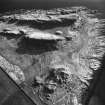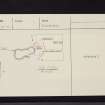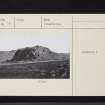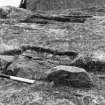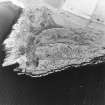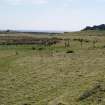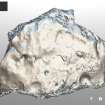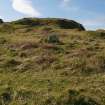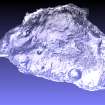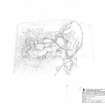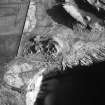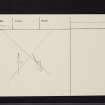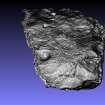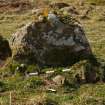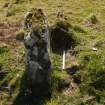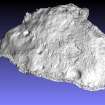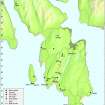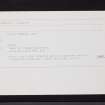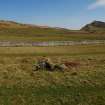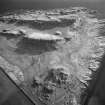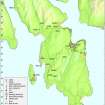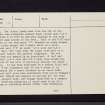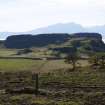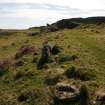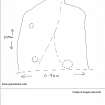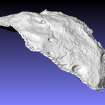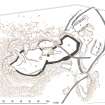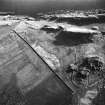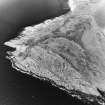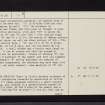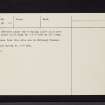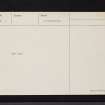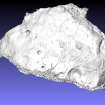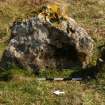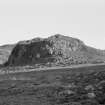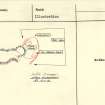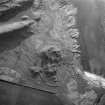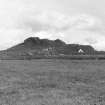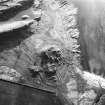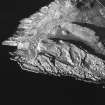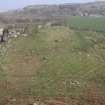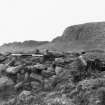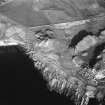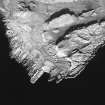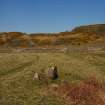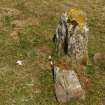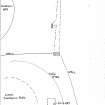Following the launch of trove.scot in February 2025 we are now planning the retiral of some of our webservices. Canmore will be switched off on 24th June 2025. Information about the closure can be found on the HES website: Retiral of HES web services | Historic Environment Scotland
Bute, Little Dunagoil
Fort (Period Unassigned), Natural Feature (Period Unassigned), Mould (Period Unassigned)
Site Name Bute, Little Dunagoil
Classification Fort (Period Unassigned), Natural Feature (Period Unassigned), Mould (Period Unassigned)
Canmore ID 40280
Site Number NS05SE 14
NGR NS 08717 53317
Datum OSGB36 - NGR
Permalink http://canmore.org.uk/site/40280
- Council Argyll And Bute
- Parish Kingarth
- Former Region Strathclyde
- Former District Argyll And Bute
- Former County Buteshire
NS05SE 14 08648 53324.
The only high ground in the neighbourhood of the fort (NS05SE 4) from whence the smallest apprehension could be entertained of its being assailed by any sort of weapons before the use of gunpowder, was a hill at some distance to the north-east, known by the name of Little Dun, or little fort, and from the remains of dykes and excavations – some natural and others appearing to be artificial - it is probable that this hill was in use to be held as an outwork to the principal garrison.
J Blain in W Ross 1880
The first hillock or little fort runs north-east and south-west or at nearly a right angle to the ridge on which the fort is placed, its highest point being towards the south-west. This hillock offers an irregular surface with numerous small plateau having precipitous or steeply sloping sides. These latter are all protected by ruined walls composed mostly of rounded stones, showing no signs of vitrifaction. The soil at the top of this fort is of a character similar to that found in ancient habitations. It is rich and loamy. Only slight digging was undertaken here, but what was done showed evidence of occupation of probably similar date to the other places. [A plan of both forts was undertaken at a scale of 19 inches to the mile (approx. 1:3300)].
J N Marshall 1915
Fragment of a clay mould for casting a large curved object, found at the "Little Fort," Dunagoil, Bute. Presented by Mrs C M Piggott, FSA Scot.
Society of Antiquaries of Scotland meeting minutes 1948
It was in 1957 that Mr C A Raleigh Radford, after visiting Little Dunagoil, suggested that it might have been used at the same time as the settlement at St Blane’s and that excavation might establish some connection between the two sites.
D N Marshall 1964
NS 087 532. The craggy site at Little Dunagoil resembles, on a small scale, the class of citadel or nuclear forts exemplified by Dunadd (NR89SW 1). Excavations in 1958-61 showed that it was occupied from the Late Bronze Age up to the 13th century. At 'A', in the SW, between outcrops, there is a steep grassy slope, pitched with stone walling. Excavations revealed post holes and a layer of occupation material. Finds made included a Late Bronze Age mould for a socketed axe, Iron Age pottery, and a comb fragment, probably Norse, 12th - 13th century. Behind the post-hole area and above the occupation layer were the remains of a much- robbed, later wall. At 'B', a little down the hillock is a flat, sheltered area. The space between two crags has been filled by a wall, similar to that at Dunadd. A single course remains at 'BB'. Though the area had been extensively occupied, no regular plan of huts could be made out. 'C' is divided from the rest of the complex by wall. 'Y': No evidence of occupation was found, and this area is thought to have been a cattle enclosure, with wall '00' to guide the animals. At 'D' and 'E' are 12th - 13th century long- houses. 'D' was 42 x 22 ft; two sherds of Samian pottery were found there, as well as other pottery of 5th - 7th, and 13th century date. 'E' was 45 x 22 ft; a stone, 3 1/2 ft high, in its E wall, has two cup marks on its inner face. A shell midden and a hearth were found in cave 'F'. A row of stones set into the ground at 'H' could not be explained. Traces of walling 'K' run round the S quadrant of the summit and over its highest point. Rampart 'R' partly encloses the complex of hillock and longhouses; the entrance may have been from the S. 'S', an outer rampart, runs parallel to 'R' for 24ft.
D N Marshall 1964.
Centred NS 0865 5330 There is little surface evidence of the early occupation revealed by excavation at Little Dunagoil (Marshall 1964) (name accepted locally); a short stretch of walling, now reduced to a grass-covered spread of stones 1.5m wide, on the S side of the summit and a length of walling (kk on plan) (Marshall 1964) are all that can be traced. The latter leads down from the top of the site and runs alongside another much ruined wall 4.0m away on its N to form an entrance passage at the only point of easy access to the fort. Just to the N of this entrance is the enclosure 'C', bounded by steep slopes on all sides except the W where there is a well-preserved wall ('Y' on plan) 1.5m wide and 0.6m high. Wall '00' runs down the slope from here to a point just behind the eastern longhouse. The two longhouses are generally as described. A turf and stone wall 2.0m wide and 0.8m high runs around the east side of the hill to partially enclose the whole complex. It has been destroyed by a modern field wall on the N but reappears just to the W where it is accompanied for a short distance by an outer bank. This turf wall also runs southwards from Little Dunagoil for about 300.0m and appears to enclose all the land on its seaward side, and though described as a rampart by the previous authority it would seem to be of a defining or confining nature rather then defensive.
At NS 0861 5333 under the W facing cliff is a cave (F on plan) 2.0m high by 1.5m wide by 5.0 long. The finds from this site are in Rothesay Museum.
Surveyed at 1:10 000.
Visited by OS (B S) 11 November 1976.
(Clay mould for socketed axe of Roseberry Topping variant of Sompting type). Single find. Mould of clay, blade part only. Length 155mm, length of matrix 115mm, width of cutting on matrix 89mm. Rothesay Museum (reg. unknown).
P K Schmidt and C B Burgess 1981.
There is a mould for a knobbed spear-butt from Little Dunagoil, Bute, a fort usually dated
to the first century BC-AD (Macgregor 1976, 85). But it seems unlikely on present evidence that
knobbed spear-butts are as early as this, and there is also 'Dark-Age' occupation at Little
Dunagoil, indicated by post-Roman pottery (Marshall 1964).
L Laing and J Laing 1987
A new survey was undertaken in March-April 1994 and November 1994 of the forts and environs of Dunagoil, Bute, which revealed a number of structural features hitherto unrecorded, and helped to clarify anomalies in previous reports of the sites. During the course of the survey a fragment of jet bracelet and coarse pottery sherd were recovered from mole-hills in the summit of Little Dunagoil fort. These have been deposited in the Bute Museum at Rothesay (Reg nos: BM 1994.100 and 1994. 101 respectively).
Sponsor: University of Edinburgh, Department of Archaeology.
Harding, Ralston and Burgess 1994.
NS 086 533-084 531 A second season of survey work was carried out on the site of the two forts at Dunagoil on the SW coast of the Isle of Bute. This season saw the completion of the detailed topographic survey of an area measuring c1000m by 500m, and allowed comprehensive three-dimensional models to be formed to aid in the understanding of the location and topography of the sites.
A further stage of field work will be required for verification of the features surveyed before publicatoin.
D W Harding, I Ralston and C Burgess 1995
This site was noted during a coastal zone assessment survey undertaken by CFA Archaeology Ltd to characterise the state of coastal erosion and the threat it poses to cultural heritage sites. A gazetteer in the report included a note of existing records and new sites when discovered. Where the site was located, notes included condition, period/date and recommendations.
Commissioned by The Scape Trust and Firth of Clyde Forum on behalf of Historic Scotland.
Cressey and Johnson 2004
A re-assessment of the Dunagoil complex was undertaken in the light of the survey of 1994 to 1995 and a re-examination of the finds from the main vitrified fort (NS05SE 4), which are now held in Bute Museum, Rothesay. The new survey of Little Dunagoil (NS05SE 14) clarified the plan of the near continuous circuit of walling at the lower NE end of the fort and also the nature and extent of features below the fort (NS05SE 30) that include buildings and a complex of enclosure banks first excavated by Marshall in 1964.
D W Harding 2004
This fort is situated on a volcanic plug in rough ground about 400m SW of Dunagoil farmstead (NS05SE 44) and about 300m NE of the more substantial vitrified fort at Dunagoil (NS05SE 4). The enclosed area measures about 75m from SW to NE by 20m and is shaped in plan like a dumbell, slightly enlarged at the SW end. There are three flattish areas in the interior, which were excavated by D N Marshall between 1958 and 1962; two at the SW (Areas A and B) and one lower area at the NE (Area C), connected by a narrower section sloping from NW to SE. The edges of the volcanic plug are less precipitous to the S and SE and it is here that the best preserved sections of rampart survive, though it is visible at other points round the circumference. A later, better preserved and narrower bank straddles the interior cutting off area C. Blain, writing in the early 19th century, mentions the 'Little Dun' describing the mixture of natural and artificial dykes and excavations, and supposing that it was probably an outwork to Dunagoil (1880, 79).
The adjacent farmstead, possibly occupied in the Norse period, is considered elsewhere (NS05SE 30).
Visited by RCAHMS (GFG, AGCH, ARG, IP) 20 March 2009.
Reference (1880)
The only high ground in the neighbourhood of the fort (NS05SE 4) from whence the smallest apprehension could be entertained of its being assailed by any sort of weapons before the use of gunpowder, was a hill at some distance to the north-east, known by the name of Little Dun, or little fort, and from the remains of dykes and excavations – some natural and others appearing to be artificial - it is probable that this hill was in use to be held as an outwork to the principal garrison.
J Blain in W Ross 1880
Excavation (1915)
The first hillock or little fort runs north-east and south-west or at nearly a right angle to the ridge on which the fort is placed, its highest point being towards the south-west. This hillock offers an irregular surface with numerous small plateau having precipitous or steeply sloping sides. These latter are all protected by ruined walls composed mostly of rounded stones, showing no signs of vitrifaction. The soil at the top of this fort is of a character similar to that found in ancient habitations. It is rich and loamy. Only slight digging was undertaken here, but what was done showed evidence of occupation of probably similar date to the other places.
J N Marshall 1915
Measured Survey (1915)
Artefact Recovery (1948)
Fragment of a clay mould for casting a large curved object, found at the "Little Fort," Dunagoil, Bute. Presented by Mrs C. M. PIGGOTT, F.S.A.Scot.
Society of Antiquaries of Scotland meeting minutes 1948
Field Visit (1957)
It was in 1957 that Mr C A Raleigh Radford, after visiting Little Dunagoil, suggested that it might have been used at the same time as the settlement at St Blane’s and that excavation might establish some connection between the two sites.
D N Marshall 1964
Desk Based Assessment (18 June 1976)
NS 087 532. The craggy site at Little Dunagoil resembles, on a small scale, the class of citadel or nuclear forts exemplified by Dunadd (NR89SW 1). Excavations in 1958-61 showed that it was occupied from the Late Bronze Age up to the 13th century. At 'A', in the SW, between outcrops, there is a steep grassy slope, pitched with stone walling. Excavations revealed post holes and a layer of occupation material. Finds made included a Late Bronze Age mould for a socketed axe, Iron Age pottery, and a comb fragment, probably Norse, 12th - 13th century. Behind the post-hole area and above the occupation layer were the remains of a much- robbed, later wall. At 'B', a little down the hillock is a flat, sheltered area. The space between two crags has been filled by a wall, similar to that at Dunadd. A single course remains at 'BB'. Though the area had been extensively occupied, no regular plan of huts could be made out. 'C' is divided from the rest of the complex by wall. 'Y': No evidence of occupation was found, and this area is thought to have been a cattle enclosure, with wall '00' to guide the animals. At 'D' and 'E' are 12th - 13th century long- houses. 'D' was 42 x 22 ft; two sherds of Samian pottery were found there, as well as other pottery of 5th - 7th, and 13th century date. 'E' was 45 x 22 ft; a stone, 3 1/2 ft high, in its E wall, has two cup marks on its inner face. A shell midden and a hearth were found in cave 'F'. A row of stones set into the ground at 'H' could not be explained. Traces of walling 'K' run round the S quadrant of the summit and over its highest point. Rampart 'R' partly encloses the complex of hillock and longhouses; the entrance may have been from the S. 'S', an outer rampart, runs parallel to 'R' for 24ft.
Information from OS (IF) 18 June 1976
Field Visit (11 November 1976)
Centred NS 0865 5330 There is little surface evidence of the early occupation revealed by excavation at Little Dunagoil (Marshall 1964) (name accepted locally); a short stretch of walling, now reduced to a grass-covered spread of stones 1.5m wide, on the S side of the summit and a length of walling (kk on plan) (Marshall 1964) are all that can be traced. The latter leads down from the top of the site and runs alongside another much ruined wall 4.0m away on its N to form an entrance passage at the only point of easy access to the fort. Just to the N of this entrance is the enclosure 'C', bounded by steep slopes on all sides except the W where there is a well-preserved wall ('Y' on plan) 1.5m wide and 0.6m high. Wall '00' runs down the slope from here to a point just behind the eastern longhouse. The two longhouses are generally as described. A turf and stone wall 2.0m wide and 0.8m high runs around the east side of the hill to partially enclose the whole complex. It has been destroyed by a modern field wall on the N but reappears just to the W where it is accompanied for a short distance by an outer bank. This turf wall also runs southwards from Little Dunagoil for about 300.0m and appears to enclose all the land on its seaward side, and though described as a rampart by the previous authority it would seem to be of a defining or confining nature rather then defensive.
At NS 0861 5333 under the W facing cliff is a cave (F on plan) 2.0m high by 1.5m wide by 5.0 long. The finds from this site are in Rothesay Museum.
Surveyed at 1:10 000.
Visited by OS (B S) 11 November 1976.
Reference (1981)
(Clay mould for socketed axe of Roseberry Topping variant of Sompting type). Single find. Mould of clay, blade part only. Length 155mm, length of matrix 115mm, width of cutting on matrix 89mm. Rothesay Museum (reg. unknown).
P K Schmidt and C B Burgess 1981.
Reference (1987)
There is a mould for a knobbed spear-butt from Little Dunagoil, Bute, a fort usually dated
to the first century BC-AD (Macgregor 1976, 85). But it seems unlikely on present evidence that
knobbed spear-butts are as early as this, and there is also 'Dark-Age' occupation at Little
Dunagoil, indicated by post-Roman pottery (Marshall 1964).
L Laing and J Laing 1987
Reference (1992)
Measured Survey (March 1994 - 1995)
A new survey was undertaken in March-April 1994 and November 1994 of the forts and environs of Dunagoil, Bute, which revealed a number of structural features hitherto unrecorded, and helped to clarify anomalies in previous reports of the sites. During the course of the survey a fragment of jet bracelet and coarse pottery sherd were recovered from mole-hills in the summit of Little Dunagoil fort. These have been deposited in the Bute Museum at Rothesay (Reg nos: BM 1994.100 and 1994. 101 respectively).
Sponsor: University of Edinburgh, Department of Archaeology.
Harding, Ralston and Burgess 1994.
NS 086 533-084 531 A second season of survey work was carried out on the site of the two forts at Dunagoil on the SW coast of the Isle of Bute. This season saw the completion of the detailed topographic survey of an area measuring c1000m by 500m, and allowed comprehensive three-dimensional models to be formed to aid in the understanding of the location and topography of the sites.
A further stage of field work will be required for verification of the features surveyed before publicatoin.
D W Harding, I Ralston and C Burgess 1995
Artefact Recovery (March 1994 - November 1994)
During the coarse of the survey a fragment of jet bracelet and coarse pottery sherd were recovered from mole-hills in the summit of Dunagoil fort.
Harding, Ralston and Burgess 1994.
Field Visit (December 2003)
This site was noted during a coastal zone assessment survey undertaken by CFA Archaeology Ltd to characterise the state of coastal erosion and the threat it poses to cultural heritage sites. A gazetteer in the report included a note of existing records and new sites when discovered. Where the site was located, notes included condition, period/date and recommendations.
Commissioned by The Scape Trust and Firth of Clyde Forum on behalf of Historic Scotland.
Cressey and Johnson 2004
Reference (2004)
A re-assessment of the Dunagoil complex was undertaken in the light of the survey of 1994 to 1995 and a re-examination of the finds from the main vitrified fort (NS05SE 4), which are now held in Bute Museum, Rothesay. The new survey of Little Dunagoil (NS05SE 14) clarified the plan of the near continuous circuit of walling at the lower NE end of the fort and also the nature and extent of features below the fort (NS05SE 30) that include buildings and a complex of enclosure banks first excavated by Marshall in 1964.
D W Harding 2004
Field Visit (20 March 2009)
This fort is situated on a volcanic plug in rough ground about 400m SW of Dunagoil farmstead (NS05SE 44) and about 300m NE of the more substantial vitrified fort at Dunagoil (NS05SE 4). The enclosed area measures about 75m from SW to NE by 20m and is shaped in plan like a dumbell, slightly enlarged at the SW end. There are three flattish areas in the interior, which were excavated by D N Marshall between 1958 and 1962; two at the SW (Areas A and B) and one lower area at the NE (Area C), connected by a narrower section sloping from NW to SE. The edges of the volcanic plug are less precipitous to the S and SE and it is here that the best preserved sections of rampart survive, though it is visible at other points round the circumference. A later, better preserved and narrower bank straddles the interior cutting off area C. Blain, writing in the early 19th century, mentions the 'Little Dun' describing the mixture of natural and artificial dykes and excavations, and supposing that it was probably an outwork to Dunagoil (1880, 79).
The adjacent farmstead, possibly occupied in the Norse period, is considered elsewhere (NS05SE 30).
Visited by RCAHMS (GFG, AGCH, ARG, IP) 20 March 2009.
Publication Account (2009)
The archaeological complex at Dunagoil includes the vitrified fort, Little Dunagoil fort, caves and middens, cultivation remains and the buildings at the foot of Little Dunagoil. Dunagoil fort is an iconic site, which includes one of the richest collections of multi-period, small finds ranging from flint artefacts and Bronze Age spear butt moulds to a La Tene 1c type brooch. In 1995 an extensive survey of the site was undertaken by the University of Edinburgh. The resultant survey plan was included in Professor Dennis Harding’s review of the site published in the Transactions of the Buteshire Natural History Society in 2002.
The published plan was derived from a data terrain model, which provided a contour plot of the site. The plan does not clearly differentiate between natural features such as cliffs and manmade structural elements of the fort. One aim for the RCAHMS team will be to revise the plan of the site, perhaps re-working the original 1995 survey, using the latest ortho-rectified, vertical aerial photography. This will be undertaken in conjunction with the local groups and individuals, as part of the second phase of RCAHMS project of site record enhancement and will allow them to re-engage with this iconic monument.
Information from ‘The Royal Commission on the Ancient and Historical Monuments of Scotland, Commissioners’ Field Meeting 2009'.
Measured Survey (17 March 2010 - 18 March 2010)
RCAHMS surveyed the fort and farmstead at Little Dunagoil between 17-18 March 2010 with plane table and self-reducing alidade at a scale of 1:500. The plan was redrawn in vector graphics software for publication at a scale of 1:1000 (Geddes and Hale 2010, 31).
Note (10 July 2014 - 23 May 2016)
This fort occupies encloses the rocky hillock known as Little Dunagoil, comprising an irregular enclosure following the lip of the hillock at its WSW end, with what appears to be an added annexe taking in the ENE end in similar fashion. The interior of the main enclosure measures about 42m from ENE to WSW by 30m transversely (0.07ha), its perimeter made up of stony scarps and outcrops; excavations during 1956-61 (Marshall 1964) included two trenches across the perimeter, on the NW and SE respectively, but revealed little evidence for the structure of the rampart in these scarps, and though the turf was also stripped from its crest along the S flank, the excavators did not recognise what RCAHMS investigators identified in 2010 as the butted junction of the annexe rampart onto the main fort. The entrance seems to have been on the E, opening into what became the annexe, which measures internally about 48m from ENE to WSW by a maximum of 19m transversely (0.05ha) at the ENE end. There are also traces of walling around a lower terrace on the N. The excavations included two areas within the fort, and a third at the ENE end of the annexe, this latter proving featureless. Evidence of occupation was recovered in the other two, but no coherent structural remains. Finds include: part of a shale ring and 40 sherds of pottery from the rear of the rampart on the SE; a fragment of a comb and five sherds of 'grass-tempered' pottery and unstratified fragments of a mould for a Late Bronze Age axe (Schmidt and Burgess 1981, 246, no.1642) from the W sector of the interior; and a pendant and armlet fragment of shale, a serpentine ring, and a whorl, an awl, a pin and a knife handle of bone from the northern sector. The excavations also included two rectangular buildings on a lower terrace to the ENE, from which a wide range of medieval and earlier finds were recovered, including a large assemblage of shale working debris and fragments of finished items, and two heavily worn sherds of Samian ware. There is also a mould for a knobbed spear-butt from the site (Laing and Laing 1986, 214).
Information from An Atlas of Hillforts of Great Britain and Ireland – 23 May 2016. Atlas of Hillforts SC1180
Note (24 March 2021)
Date Fieldwork Started: 24/03/2021
Compiled by: Rock Art Bute
Location Notes: This stone is built into the Norse Longhouse E wall at Little Dunagoil Fort. It lies to the E side of the hillfort within the original turf dyke enclosure. The track leads through this former building.
Panel Notes: This upright sandstone orthostat standing 0.70m high is situated on the E side of a Norse Longhouse at Little Dunagoil Fort. There are many natural hollows on the E side of the stone and the W face has one larger hollow and two smaller hollows facing into the structure. The largest is 9.5cm x 2.4cm deep. Previously recorded as cupmarks but are natural hollows. The bedrock in the area also has many natural hollows.
Additional Description: There is a mould for a knobbed spear-butt from Little Dunagoil, Bute, a fort usually dated
to the first century BC-AD (Macgregor 1976, 85). But it seems unlikely on present evidence that
knobbed spear-butts are as early as this, and there is also 'Dark-Age' occupation at Little
Dunagoil, indicated by post-Roman pottery (Marshall 1964).
L Laing and J Laing 1987
(Clay mould for socketed axe of Roseberry Topping variant of Sompting type). Single find. Mould of clay, blade part only. Length 155mm, length of matrix 115mm, width of cutting on matrix 89mm. Rothesay Museum (reg. unknown).
P K Schmidt and C B Burgess 1981.
During the coarse of the survey a fragment of jet bracelet and coarse pottery sherd were recovered from mole-hills in the summit of Dunagoil fort.
Harding, Ralston and Burgess 1994.
A new survey was undertaken in March-April 1994 and November 1994 of the forts and environs of Dunagoil, Bute, which revealed a number of structural features hitherto unrecorded, and helped to clarify anomalies in previous reports of the sites. During the course of the survey a fragment of jet bracelet and coarse pottery sherd were recovered from mole-hills in the summit of Little Dunagoil fort. These have been deposited in the Bute Museum at Rothesay (Reg nos: BM 1994.100 and 1994. 101 respectively).
Sponsor: University of Edinburgh, Department of Archaeology.
Harding, Ralston and Burgess 1994.
NS 086 533-084 531 A second season of survey work was carried out on the site of the two forts at Dunagoil on the SW coast of the Isle of Bute. This season saw the completion of the detailed topographic survey of an area measuring c1000m by 500m, and allowed comprehensive three-dimensional models to be formed to aid in the understanding of the location and topography of the sites.
A further stage of field work will be required for verification of the features surveyed before publicatoin.
D W Harding, I Ralston and C Burgess 1995
A re-assessment of the Dunagoil complex was undertaken in the light of the survey of 1994 to 1995 and a re-examination of the finds from the main vitrified fort (NS05SE 4), which are now held in Bute Museum, Rothesay. The new survey of Little Dunagoil (NS05SE 14) clarified the plan of the near continuous circuit of walling at the lower NE end of the fort and also the nature and extent of features below the fort (NS05SE 30) that include buildings and a complex of enclosure banks first excavated by Marshall in 1964.
D W Harding 2004
The first hillock or little fort runs north-east and south-west or at nearly a right angle to the ridge on which the fort is placed, its highest point being towards the south-west. This hillock offers an irregular surface with numerous small plateau having precipitous or steeply sloping sides. These latter are all protected by ruined walls composed mostly of rounded stones, showing no signs of vitrifaction. The soil at the top of this fort is of a character similar to that found in ancient habitations. It is rich and loamy. Only slight digging was undertaken here, but what was done showed evidence of occupation of probably similar date to the other places.
J N Marshall 1915
This fort is situated on a volcanic plug in rough ground about 400m SW of Dunagoil farmstead (NS05SE 44) and about 300m NE of the more substantial vitrified fort at Dunagoil (NS05SE 4). The enclosed area measures about 75m from SW to NE by 20m and is shaped in plan like a dumbell, slightly enlarged at the SW end. There are three flattish areas in the interior, which were excavated by D N Marshall between 1958 and 1962; two at the SW (Areas A and B) and one lower area at the NE (Area C), connected by a narrower section sloping from NW to SE. The edges of the volcanic plug are less precipitous to the S and SE and it is here that the best preserved sections of rampart survive, though it is visible at other points round the circumference. A later, better preserved and narrower bank straddles the interior cutting off area C. Blain, writing in the early 19th century, mentions the 'Little Dun' describing the mixture of natural and artificial dykes and excavations, and supposing that it was probably an outwork to Dunagoil (1880, 79).
The adjacent farmstead, possibly occupied in the Norse period, is considered elsewhere (NS05SE 30).
Visited by RCAHMS (GFG, AGCH, ARG, IP) 20 March 2009.
Fragment of a clay mould for casting a large curved object, found at the "Little Fort," Dunagoil, Bute. Presented by Mrs C. M. PIGGOTT, F.S.A.Scot.
Society of Antiquaries of Scotland meeting minutes 1948
It was in 1957 that Mr C A Raleigh Radford, after visiting Little Dunagoil, suggested that it might have been used at the same time as the settlement at St Blane?s and that excavation might establish some connection between the two sites.
D N Marshall 1964
Centred NS 0865 5330 There is little surface evidence of the early occupation revealed by excavation at Little Dunagoil (Marshall 1964) (name accepted locally); a short stretch of walling, now reduced to a grass-covered spread of stones 1.5m wide, on the S side of the summit and a length of walling (kk on plan) (Marshall 1964) are all that can be traced. The latter leads down from the top of the site and runs alongside another much ruined wall 4.0m away on its N to form an entrance passage at the only point of easy access to the fort. Just to the N of this entrance is the enclosure 'C', bounded by steep slopes on all sides except the W where there is a well-preserved wall ('Y' on plan) 1.5m wide and 0.6m high. Wall '00' runs down the slope from here to a point just behind the eastern longhouse. The two longhouses are generally as described. A turf and stone wall 2.0m wide and 0.8m high runs around the east side of the hill to partially enclose the whole complex. It has been destroyed by a modern field wall on the N but reappears just to the W where it is accompanied for a short distance by an outer bank. This turf wall also runs southwards from Little Dunagoil for about 300.0m and appears to enclose all the land on its seaward side, and though described as a rampart by the previous authority it would seem to be of a defining or confining nature rather then defensive.
At NS 0861 5333 under the W facing cliff is a cave (F on plan) 2.0m high by 1.5m wide by 5.0 long. The finds from this site are in Rothesay Museum.
Surveyed at 1:10 000.
Visited by OS (B S) 11 November 1976.
SRP_PROJECT CODE : S48
NGRE changed from 0863 to 08648
NGRN changed from 5331 to 53324
17 days, May 58. 3 days Aug 58.
This site was noted during a coastal zone assessment survey undertaken by CFA Archaeology Ltd to characterise the state of coastal erosion and the threat it poses to cultural heritage sites. A gazetteer in the report included a note of existing records and new sites when discovered. Where the site was located, notes included condition, period/date and recommendations.
Commissioned by The Scape Trust and Firth of Clyde Forum on behalf of Historic Scotland.
Cressey and Johnson 2004
The only high ground in the neighbourhood of the fort (NS05SE 4) from whence the smallest apprehension could be entertained of its being assailed by any sort of weapons before the use of gunpowder, was a hill at some distance to the north-east, known by the name of Little Dun, or little fort, and from the remains of dykes and excavations ? some natural and others appearing to be artificial - it is probable that this hill was in use to be held as an outwork to the principal garrison.
J Blain in W Ross 1880
The archaeological complex at Dunagoil includes the vitrified fort, Little Dunagoil fort, caves and middens, cultivation remains and the buildings at the foot of Little Dunagoil. Dunagoil fort is an iconic site, which includes one of the richest collections of multi-period, small finds ranging from flint artefacts and Bronze Age spear butt moulds to a La Tene 1c type brooch. In 1995 an extensive survey of the site was undertaken by the University of Edinburgh. The resultant survey plan was included in Professor Dennis Harding?s review of the site published in the Transactions of the Buteshire Natural History Society in 2002.
The published plan was derived from a data terrain model, which provided a contour plot of the site. The plan does not clearly differentiate between natural features such as cliffs and manmade structural elements of the fort. One aim for the RCAHMS team will be to revise the plan of the site, perhaps re-working the original 1995 survey, using the latest ortho-rectified, vertical aerial photography. This will be undertaken in conjunction with the local groups and individuals, as part of the second phase of RCAHMS project of site record enhancement and will allow them to re-engage with this iconic monument.
Information from `The Royal Commission on the Ancient and Historical Monuments of Scotland, Commissioners? Field Meeting 2009'.
NS 087 532. The craggy site at Little Dunagoil resembles, on a small scale, the class of citadel or nuclear forts exemplified by Dunadd (NR89SW 1). Excavations in 1958-61 showed that it was occupied from the Late Bronze Age up to the 13th century. At 'A', in the SW, between outcrops, there is a steep grassy slope, pitched with stone walling. Excavations revealed post holes and a layer of occupation material. Finds made included a Late Bronze Age mould for a socketed axe, Iron Age pottery, and a comb fragment, probably Norse, 12th - 13th century. Behind the post-hole area and above the occupation layer were the remains of a much- robbed, later wall. At 'B', a little down the hillock is a flat, sheltered area. The space between two crags has been filled by a wall, similar to that at Dunadd. A single course remains at 'BB'. Though the area had been extensively occupied, no regular plan of huts could be made out. 'C' is divided from the rest of the complex by wall. 'Y': No evidence of occupation was found, and this area is thought to have been a cattle enclosure, with wall '00' to guide the animals. At 'D' and 'E' are 12th - 13th century long- houses. 'D' was 42 x 22 ft; two sherds of Samian pottery were found there, as well as other pottery of 5th - 7th, and 13th century date. 'E' was 45 x 22 ft; a stone, 3 1/2 ft high, in its E wall, has two cup marks on its inner face. A shell midden and a hearth were found in cave 'F'. A row of stones set into the ground at 'H' could not be explained. Traces of walling 'K' run round the S quadrant of the summit and over its highest point. Rampart 'R' partly encloses the complex of hillock and longhouses; the entrance may have been from the S. 'S', an outer rampart, runs parallel to 'R' for 24ft.
Information from OS (IF) 18 June 1976
NS05SE 14 08648 53324.
The only high ground in the neighbourhood of the fort (NS05SE 4) from whence the smallest apprehension could be entertained of its being assailed by any sort of weapons before the use of gunpowder, was a hill at some distance to the north-east, known by the name of Little Dun, or little fort, and from the remains of dykes and excavations ? some natural and others appearing to be artificial - it is probable that this hill was in use to be held as an outwork to the principal garrison.
J Blain in W Ross 1880
The first hillock or little fort runs north-east and south-west or at nearly a right angle to the ridge on which the fort is placed, its highest point being towards the south-west. This hillock offers an irregular surface with numerous small plateau having precipitous or steeply sloping sides. These latter are all protected by ruined walls composed mostly of rounded stones, showing no signs of vitrifaction. The soil at the top of this fort is of a character similar to that found in ancient habitations. It is rich and loamy. Only slight digging was undertaken here, but what was done showed evidence of occupation of probably similar date to the other places. [A plan of both forts was undertaken at a scale of 19 inches to the mile (approx. 1:3300)].
J N Marshall 1915
Fragment of a clay mould for casting a large curved object, found at the "Little Fort," Dunagoil, Bute. Presented by Mrs C M Piggott, FSA Scot.
Society of Antiquaries of Scotland meeting minutes 1948
It was in 1957 that Mr C A Raleigh Radford, after visiting Little Dunagoil, suggested that it might have been used at the same time as the settlement at St Blane?s and that excavation might establish some connection between the two sites.
D N Marshall 1964
NS 087 532. The craggy site at Little Dunagoil resembles, on a small scale, the class of citadel or nuclear forts exemplified by Dunadd (NR89SW 1). Excavations in 1958-61 showed that it was occupied from the Late Bronze Age up to the 13th century. At 'A', in the SW, between outcrops, there is a steep grassy slope, pitched with stone walling. Excavations revealed post holes and a layer of occupation material. Finds made included a Late Bronze Age mould for a socketed axe, Iron Age pottery, and a comb fragment, probably Norse, 12th - 13th century. Behind the post-hole area and above the occupation layer were the remains of a much- robbed, later wall. At 'B', a little down the hillock is a flat, sheltered area. The space between two crags has been filled by a wall, similar to that at Dunadd. A single course remains at 'BB'. Though the area had been extensively occupied, no regular plan of huts could be made out. 'C' is divided from the rest of the complex by wall. 'Y': No evidence of occupation was found, and this area is thought to have been a cattle enclosure, with wall '00' to guide the animals. At 'D' and 'E' are 12th - 13th century long- houses. 'D' was 42 x 22 ft; two sherds of Samian pottery were found there, as well as other pottery of 5th - 7th, and 13th century date. 'E' was 45 x 22 ft; a stone, 3 1/2 ft high, in its E wall, has two cup marks on its inner face. A shell midden and a hearth were found in cave 'F'. A row of stones set into the ground at 'H' could not be explained. Traces of walling 'K' run round the S quadrant of the summit and over its highest point. Rampart 'R' partly encloses the complex of hillock and longhouses; the entrance may have been from the S. 'S', an outer rampart, runs parallel to 'R' for 24ft.
D N Marshall 1964.
Centred NS 0865 5330 There is little surface evidence of the early occupation revealed by excavation at Little Dunagoil (Marshall 1964) (name accepted locally); a short stretch of walling, now reduced to a grass-covered spread of stones 1.5m wide, on the S side of the summit and a length of walling (kk on plan) (Marshall 1964) are all that can be traced. The latter leads down from the top of the site and runs alongside another much ruine
This fort occupies encloses the rocky hillock known as Little Dunagoil, comprising an irregular enclosure following the lip of the hillock at its WSW end, with what appears to be an added annexe taking in the ENE end in similar fashion. The interior of the main enclosure measures about 42m from ENE to WSW by 30m transversely (0.07ha), its perimeter made up of stony scarps and outcrops; excavations during 1956-61 (Marshall 1964) included two trenches across the perimeter, on the NW and SE respectively, but revealed little evidence for the structure of the rampart in these scarps, and though the turf was also stripped from its crest along the S flank, the excavators did not recognise what RCAHMS investigators identified in 2010 as the butted junction of the annexe rampart onto the main fort. The entrance seems to have been on the E, opening into what became the annexe, which measures internally about 48m from ENE to WSW by a maximum of 19m transversely (0.05ha) at the ENE end. There are also traces of walling around a lower terrace on the N. The excavations included two areas within the fort, and a third at the ENE end of the annexe, this latter proving featureless. Evidence of occupation was recovered in the other two, but no coherent structural remains. Finds include: part of a shale ring and 40 sherds of pottery from the rear of the rampart on the SE; a fragment of a comb and five sherds of 'grass-tempered' pottery and unstratified fragments of a mould for a Late Bronze Age axe (Schmidt and Burgess 1981, 246, no.1642) from the W sector of the interior; and a pendant and armlet fragment of shale, a serpentine ring, and a whorl, an awl, a pin and a knife handle of bone from the northern sector. The excavations also included two rectangular buildings on a lower terrace to the ENE, from which a wide range of medieval and earlier finds were recovered, including a large assemblage of shale working debris and fragments of finished items, and two heavily worn sherds of Samian ware. There is also a mould for a knobbed spear-butt from the site (Laing and Laing 1986, 214).
Information from An Atlas of Hillforts of Great Britain and Ireland ? 23 May 2016. Atlas of Hillforts SC1180
SRA plan at 1:500
































































